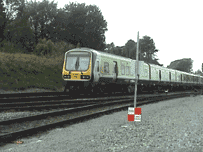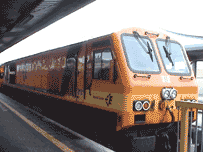IARNROD EIREANN GO BRAGH
20 Oct 2004
Andy Milne talks to Dick Fearn, about the refreshing challenges of his new role as Chief Operating Officer of Iarnrod Eireann
Pouring out tea in an old high ceilinged office, headquarters of Iarnrod Eireann, Dick Fearn, 49, has the relaxed demeanour of a man entering his classic gold career sweep.
Iarnrod Eireann, vertically integrated, state owned and healthily invested, is a railwayman’s dream. ‘People ask if I took this job because I was unhappy at Network Rail. It wasn’t that at all,’ protests Dick Fearn. ‘I was approached and asked if I’d be interested.’
Dick, from Crewe, Cheshire, came over one weekend to have a quiet look round. There’s nothing quiet about Ireland. The Dublin skyline is spiked with tower cranes, the streets alive with jack hammers and the clatter of scaffolders. Building sites crater the landscape and bars are packed with French engineers, Poles, Slovaks and Czechs.
‘I could see things were happening. I saw the reconstruction at Heuston Station and new rolling stock.’ Intrigued he flew home.
DART
The rebirth of Ireland’s railway industry dates back to 1997. On 8th November 1997 the Heuston - Westport service derailed at Knockcroghery. Four people were injured. As Tim O’Brien of the Irish Times puts it, ‘We’d hardly spent a dollar on railway investment since independence and now it was starting to fall apart quite literally under the trains.’
What money had been available had been funnelled into the Dublin Area Rapid Transit system 20 years ago. Minister for Public Enterprise, Mary O’Rourke, realised Ireland faced a stark choice. Close the railway or make it safe. O’Rourke made the case for railways and the government, emboldened by EU funding largesse, launched the Safety Investment Programme. Ireland’s railways were back on track.
Sanguine
For Fearn the 1990s saw all the trauma of privatisation, failed MBOs, Hatfield and the sequestration of Railtrack. For a professional railwayman it was a difficult decade. Fearn, ever sanguine, kept the faith.
In the corner of his office stands a small replica of a statue of a navvy. The real sized statue, marking Chiltern line modernisation, stands at Gerrards Cross. At the time rock band Genesis released an album ‘We Can’t Dance’ on which is a track ‘Driving the last spike’ all about the privations of the navvies.
Dick rang them up. Collins and co. were on tour, but a letter arrived a few days later saying although they wouldn’t be at the unveiling, they would happily pick up the tab for the cost of the statue. ‘It has followed me ever since and is more appropriate here than anywhere, because many of those workers that we were commemorating, would have come from this country.’
Classic 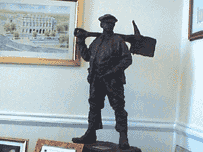
Dick Fearn joined BR in 1973 as a management trainee. He read Business Studies at Wolverhampton Polytechnic. ‘I followed the classic, well trodden, path, supervising a marshalling yard, station manager at Doncaster and operations at Leeds.’
In the mid-1980s at the behest of his boss, Paul Watkinson (former BRB personn
el director), Dick took a transport economics masters degree at Leeds. BR started to move into business management in a big way. He eventually worked for Chris Green at Network South East.
‘OFQ, Organising For Quality, was good for me. I became divisional director for Thames and Chiltern.’ In the run up to privatisation Dick headed up the South Eastern shadow franchise and staged an MBO. Connex took the franchise. Dick describes himself, along with all BR managers as ‘gutted.’ After two years he met Gerald Corbett, head of Railtrack.
Fearn is nothing if not loyal to his friends. ‘I saw Gerald in a very positive
light. I found him a very motivating sort of guy.’ Corbett offered him a job as zonal director for the North West. ‘I grabbed the opportunity’ Two y
ears later he headed up Midland Zone. Then came the call from Ireland and after 30 years in the UK he found he couldn’t say no.
‘I would have regretted it, if I hadn’t taken the job. Every now and then there are windows in your life when you can do these kind of things aren’t there?’ Dick and his wife Janet live in Killinie south of Dublin and he commutes in every day on the DART. Their grown up daughter, Hannah, is a journalist with Mirror group newspapers in London.
Vibrancy
Iarnrod Eireann is a state owned, vertically integrated, high-investment railway. Fearn is hesitant about criticising UK rail structure. However, he says, ‘The industry has felt tired of change and people have a great burden on their shoulders. You won’t sense that here at all. There’s a great desire for the railway to do more.’
Ireland is a young persons country. Over a third of the staff on Iarnrod Eireann have joined in the last five years, numbers are up from 4,900 in 1997 to 5,500 today. ‘We haven’t declared parched earth at rural stations. Many look good and there is a nucleus of key staff at these places.’
Certainly Irish stations are well tended and well staffed. You can still send parcels and flowers on Iarnrod Eireann trains. ‘There’s a great vibrancy in the economy. People are not emigrating any more!’
‘Frequency of service is very, very low. When I came here I got out the working timetable and I thought: Where’s all the trains!? Five to Galway a day! Even Cork has 2 1/2 hour gaps between trains. We have to ramp up frequency. The very positive stance of the Irish government means we have the opportunity to do this.
The first chance came in December 2003 with the delivery of 20 x 4 car sets, Class 2900s, from CAF. Iarnrod Eireann Commuter ramped up service levels throughout the day. Iarnrod Eireann has three defined brands, DART, Commuter and Inter City. The second opportunity is the DART upgrade. New trains - 8 cars as opposed to 6 cars and longer platforms will increase capacity 30%.
Inter City added two more services on the Waterford and Galway run. ‘The main focus will be the Dublin - Cork route. It’s double track, Cork is Ireland’s 2nd city, 2 hours 45 minutes by rail, four by car. We ought to be able to sweep the board on Dublin - Cork but we can’t do it yet because there’s not the frequency.’
The plan is to use the ten year old Class 201 locomotives, ‘They’re basically class 66s upgraded for speed, ten years old. We have ordered from CAF new coaches and drive end trailers, 67 vehicles, which will run in eight car formations.’ This included first class and a restaurant car. ‘With eight of these we can go hourly all day every day from Dublin to Cork.’ The new coaches are expected in mid-2005.
Tender
For InterCity it’s just the start. ‘We’ve got Dublin, Limerick, Waterford, Galway, Westport and Sligo. We’ve gone out to tender for a new generation of regional InterCity DMUs.’ The plan is to buy another thirty trains comprised of 10 x 6 car trains and 20 x 3 car trains.
The six cars will have good catering facilities, 1st class and standard with power distributed under all the vehicles. The 20 x 3 car sets will look the same but will be a standard class train used for regional feeder services.
There is no question of closing lines in Ireland. The day before the interview Dick had been joined by Transport Minister Sean Brennan at the re-opening of the line between Limerick and Waterford. This had been closed when a freight train derailed at Cahir destroying the viaduct.
‘It was a modestly used line for passengers, but carried quite a bit of freight, including sugar beet and cement. On the 24th September we had an excellent launch with a better passenger service than before and using DMUs.’
It’s the same on the Limerick - Ennis line after track renewals. ‘We now have seven trains a day in each direction using a two car dmu.’ Previously there was just one a day. Dick is quick to point out this is another lesson learnt from old Provincial days on BR: Increase train frequencies and people will come back.
‘We will place the order by the end of the year. Deliveries will start during 2007 with a launch date in December 2007. The investment in the 120 new vehicles will total 250 million Euros.’
Where’s all the money coming from? Initially EU grants helped. Now with the surge in the economy, there is a tax surplus. The Irish government remains steadfast in its support for rail - all of it. These are no empty promises.
How much control does Fearn have over the railway? He reports to Iarnrod Eireann’s managing director, Joe Meagher. ‘I don’t have the long term investment delivery, but I do have day to day infrastructure maintenance.
The chief infrastructure engineer, Brian Garvey, is a direct report to me. Around my table are all the people that are necessary for day to day operations. You have to be able to deal with TSRs, everything, which is what we always had in old BR days and certainly had under OFQ.
Why was OFQ working so well? Because we all had manageable bits that we could look after. We had all the levers to pull. The credit for that is due to (BR chairman) Bob Reid 2, the oil man. He had a clear vision that he needed people out there who felt accountable for their bit.’
Experience
Inevitably there was to be re-organisation. ‘Organisational structure was very, very departmentalised. What I felt I needed was some general managers out there in the field who could pull together the threads.’ Fearn has created five general managers: Freight, Rosslare Harbour, DART, and two for the national passenger network.
Steve Ahearn is GM Freight. ‘It’s rubbish to suggest we are giving up on freight. We’re not. See those cement tanks going past?’ Fearn waves out of the window as, on cue, a freight train purrs past on the viaduct outside.
‘That’s Irish Cement, they’re big customers of ours. We move cement from Platin Cement Works to Waterford. The Kingscourt line also takes gypsum. We’ve new flows of timber from Sligo to Waterford for shipment. Waterford port is very successful and has a big commitment from the Irish governments. It’s great for us,’ admits Fearn ruefully - Waterford is right in the south east of the country at the end of a long rail trunk route.
Rosslare Harbour is run by Iarnrod Eireann. ‘I thought it important to have a Mr. Rosslare - wholly in charge of the harbour.’ The GM Rosslare is Michael Murphy, a former reserve officer in the Irish Navy.
The passenger sector is divided into DART, Commuter and Inter City. Again Fearn bases his new structures on experience. ‘I actually wanted clear, defined, geography. One thing OFQ gave us was clarity on geography.’ GM DART is Tom Devoy an established Iarnrod Eireann hand, looking after the whole of the DART.
Steve Murphy is GM South and West and looks after the old southern and western railway - apart from the Waterford - Heuston line. Steve is a Londoner of Irish extraction. ‘His Mum and Dad emigrated in 1961 and came from Limerick. He’s brought his family over here and made it his home,’ says Dick. Steve now lives in Dublin.
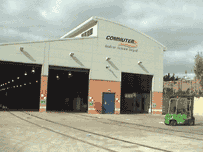
Cal Carmichael is GM North and East, looking after services from Connolly station - this includes lines to Sligo, Belfast, Rosslare and Waterford. Cal Carmichael is Scottish and his wife is from County Armagh. ‘They’ve got a young family and she was keen to come back. They live up on the border in Armagh and Cal commutes in from Dundalk.’ Cal joined from Network Rail Scotland where he managed the eastern zone.
New trains draw people back to Ireland’s railways. Numbers soared to 35.6 million journeys last year. The track, post-Knockcroghery has been replaced. Whole arterial routes are now CWR (Continuous Welded Rail). A huge amount of local renewals continue.
‘We are resignalling the whole network which will be controlled by the Central Traffic Control unit at Dublin Connolly. Eventually all Ireland will be signalled from Connolly. Currently the lines from Dublin to Cork and Galway and the DART are run from the CTC.
Backing Ireland
Iarnrod Eireann remains a heavily subsidised railway. However, under the Meagher - Fearn ticket it is an expanding railway generating income. More importantly it is avoiding the black hole economics of the UK’s rail privatisation and the extravagance of continental railways.
Says Dick, ‘We have our watchdogs in the press, that’s true. But in general there’s this view that we’re playing for Ireland. We’re backing Ireland and you don’t find that in the UK.’
His relations with government are equally sanguine. Transport Minster, Sean Brennan is consistently supportive, even turning out on Sunday at the 150th anniversary celebrations of Bray station. ‘We have a service level agreement including punctually and capacity. It is against the agreement that we deliver. There’s not this adversarial thing, it’s much less of a blunt instrument. It’s done in an environment of win-win.’
Is there a threat of privatisation? Certainly, the Progressive Democrats, coalition partners with ruling party Fianna Fail, want to see more private sector involvement in transport generally. However, everyone sees the folly of fragmenting a successful, vertically integrated, railway.
For Dick Fearn it must be thrilling to have slipped the surly bonds of UK rail. However, it is a tough job with a phenomenal work load. Fearn is effective as a leader for two reasons. One is his undiminished enthusiasm for people and staff. Not for nothing does a statue of a navvy hold pride of place on his mantel.
Secondly, he knows how to run a railway, using a professionalism milled by the Organising For Quality allegro and BR’s tradition of mandatory, comprehensive, operational experience. UK rail companies, by contrast, now have dozens of senior directors with no operational experience whatsoever! How long before the lamplighters of Marsham Street have the sense to look across the Irish Sea for true enlightenment?
Thanks to Mary Saunders, Barry Kenny and Tim O’Brien in Dublin and Tim Casterton in London for their help. Thanks also to Fergus O’Connor and colleague for Irish translation.
Return to News Home Page
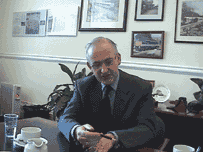
 Dick Fearn joined BR in 1973 as a management trainee. He read Business Studies at Wolverhampton Polytechnic. ‘I followed the classic, well trodden, path, supervising a marshalling yard, station manager at Doncaster and operations at Leeds.’
Dick Fearn joined BR in 1973 as a management trainee. He read Business Studies at Wolverhampton Polytechnic. ‘I followed the classic, well trodden, path, supervising a marshalling yard, station manager at Doncaster and operations at Leeds.’ 